No products in the cart.
Hand Grippers
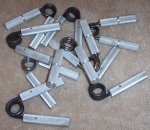
Grippers are addictive
Hand grippers are the primary tool used for training crushing grip and are often focused on to the exclusion of all other grip training. Having a strong thumb and wrist is key to closing the big grippers, so this may not be the best choice. However, work on hand grippers is what drives the initial interest in grip training for most trainees. The two common varieties of hand grippers are extension spring and torsion spring.
Extension spring grippers
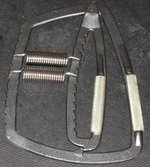
Knurled handles resolve the common problem with extension spring grippers.
Extension spring grippers differ from torsion spring grippers in that resistance opposing closure of the gripper is generated via extension of the springs, opposed to compression. The extension springs are typically attached to the gripper handles via hooks, allowing for easy modification of gripper resistance.
The most common extension gripper is the Ivanko Supergripper. This gripper is approximately the size of a pad of paper and provides an almost unlimited range of difficulty for little more than the cost of a single torsion spring gripper. The tool is not as popular as the torsion spring grippers, largely due to complaints over the comfort of the handle.
Torsion spring grippers
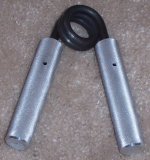
High strength gripper with aluminum handles.
Characterized by a torsion spring set in plastic, aluminum, steel, or even brass handles, this is the most common type of gripper. The gripper is closed by crushing the handles together until they touch, compressing the torsion spring. Difficulty will increase the closer the gripper handles are to touching, so it is important to close the handles until they touch.
Low strength versions of the torsion spring grippers can be purchased at almost any sporting goods store. Most trainees progress to heavy duty versions of these grippers for serious grip training. A variety of manufacturers produce heavy duty torsion spring grippers, the most widely recognized being Ironmind with their Captains of Crush line of hand grippers.
Gripper difficulty will primarily be determined by the diameter of the spring and distance between the gripper handles. Torsion spring grippers typically have a single strength, but are highly portable.
Gripper Set
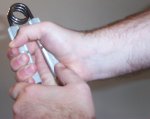
Strong thumbs maximize leverage with a deep set.
Set refers to placement of the gripper in the hand prior to closure in order to gain best leverage on the handles. Key to a good gripper set is to flex the thumb pad and position the gripper such that the pinky is halfway off the end of the gripper handle prior to the close. Liberal use of chalk on the closing hand will aid in getting a good set, by minimizing the amount the gripper will move around in the hand.
The distance between the gripper handles after setting the gripper has a significant impact on difficulty of closing the gripper. The most common styles of gripper sets are parallel, credit card width, and no set. The further the handles are from close after the set, the more difficult the gripper will be to close. Outside of the greater closing distance, the leverage on the gripper handles is reduced via less favorable positioning of the gripper with wider sets.
Impact of hand size on closing a gripper with varying set widths is often debated. An individual with small hands will have greater difficulty obtaining good leverage with a wide gripper set than an individual with large hands. Practice is needed to learn to generate maximum power with any setting style and largely offsets the impact of hand size
Gripper Dogleg

The gripper on the left has the dog leg side facing up.
Torsion spring grippers are wound such that one leg of the spring will be straighter than other. The straighter leg is referred to as the dogleg. When setting the gripper, the handle that is on the dogleg should be placed in the palm. This will provide better leverage over the gripper.
Parallel Set
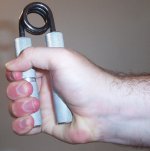
Note the position of the handles relative to the palm and the pinky.
Parallel set refers to placing the gripper in the hand such that prior to the close attempt, the handles are parallel to one another, almost an inch apart. This is achieved by pressing one gripper handle into the crease of the palm closest to the fingers and pinching the other handle down until the fingers are wrapped around it at parallel. The pinky should be halfway off the edge of the gripper handle. Closing a gripper with a parallel set it the first step to mastery of the gripper.
In order to maximize power of the parallel set, it is important to have strong thumbs on both hands. The thumb on the closing hand can be flexed prior to setting the gripper, providing a wall to hold the gripper handle in place on the crease of the palm. A strong thumb on the setting hand is essential to being able to bring hard grippers down into the parallel set position.
Credit card set
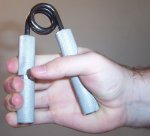
Gripper set to credit card width in a 7″ hand.
Credit card set refers to placing the gripper in the hand such that prior to the close attempt, the handles are far enough apart to pass a credit card between them width wise. This distance is approximately 2.25”. Due to the width of the initial set, the gripper must be placed further back in the hand, significantly increasing the difficulty of the close.
Introduced by Ironmind in response to concern over individuals using a parallel set on their certification, closing a gripper with a credit card set requires the ability to dominate the gripper. The Ironmind certification actually requires a credit card to be passed between the grippers handles prior to the close. Those individuals with small hands may find it easier to position the gripper with a deep set, allow it to open to credit card width, and then perform the close.
No Set Close
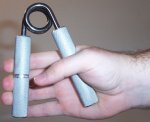
Wrap the pinky around the handle during the close.
No set refers to placing the gripper in the hand such that prior to the close attempt, there is no tension on the gripper spring. The closing hand is required to generate all force needed to shut the gripper handles. The ability to close a gripper with no set demonstrates true mastery of the gripper.
Due to the poor leverage on the gripper during the close, training no set as the primary approach for developing crushing strength is not encouraged. Risk of injury due to poor hand positioning is increased. Consistent of hand position is also more difficult to obtain, increasing difficulty of tracking progress over time. Some gripper manufactures produce grippers with a narrow spread in order to facilitate no set training for individuals with smaller hands.
Strap Hold
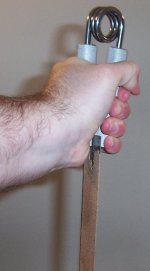
Keep the strap vertical.
Performance of a strap hold involves lifting a weight attached to a thin piece of material by crushing the material between gripper handles and lifting. Done with the gripper handles perpendicular to the ground, this exercise focuses on developing strength to dominate the gripper close. Strap material should hard and thin. A metal ruler is an ideal, low cost option.
Weights ranging from a few ounces to several pounds are typically used on this exercise. Using more than ten pounds of weight should be avoided on this exercise due to the excessive stress that will be placed on the wrist during the close. It is much better to perform a lighter strap hold with a harder gripper. Most will be able to perform a strap hold with a gripper one level below the one they are trying to master.
Overcrush
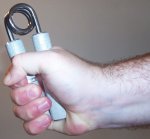
Squeeze the gripper as hard as possible.
An overcrush involves crushing the gripper handles together as hard as possible for several seconds, resulting in an isometric in the fully closed gripper position. Similar to a strap hold, this exercise is performed on a gripper one has dominance over and focuses on developing strength for the final bit of the gripper close.
Beyond the Range Training
Beyond the range training consists of working with a gripper that has a handle filed down to increase the distance the spring must be compressed to close the gripper by up to 1/4”. This serves to increase the resistance of the gripper at the close, as well allows for training closing the hand further than with a normal gripper. Often used when doing overcrushes or strap holds, this form of training is done to maximize strength at the gripper close.
Filing a gripper voids the warranty of all gripper manufacturers as it increases the possibility of the gripper spring breaking. Caution should be used when working beyond the range with filed grippers.
When filing a gripper, be sure to file down a single handle, removing a small bit of material at a time. Resistance will increase quickly. Filing both handles will result in the palm getting pinched between the handles during the close. An inexpensive solution for filing down a gripper handle is to use a bastard mill file, which can be acquired at a hardware store for a few dollars.
Choker Collar
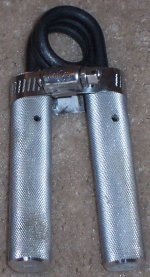
Choked with a hose clamp around the handles.
Choker collars are used to lock the gripper into a partially shut position for training explosiveness on the gripper close. Typically a washer applied to the bottom of the exposed spring or hose clamp applied to the top of the gripper handles, a choker collar prevents a gripper from opening more than the desired amount.
Locking the gripper into a partially shuts position allows for practice of explosive closes and severe negatives on a gripper stronger than one would normally train with. Typically gripper handles are choked to distances ranging from one inch to almost completely shut. Leaving a gripper choked for an extended period of time should not impact its strength. It is possible for a strong gripper to break a weak hose clamp.
Working with choked grippers has the advantage of allowing for high volume or intensity work without the need to set a gripper on every attempt. When working with a gripper at or beyond an individual’s maximum closing strength, this can greatly reduce stress on the knuckles from setting the gripper and releasing it after a negative. Chokers are excellent tools for injury prevention.
Severe Negative
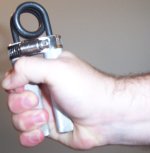
Use a choker collar during negatives to protect the knuckles.
Severe negatives are performed by forcing a gripper shut with two hands, then attempting to hold it shut with one. The primary purpose is to expose tissues of the hand to the force of stronger grippers, building the toughness needed to generate high levels of closing force. For maximum benefit, focus on crushing the gripper shut during the negative, not just preventing it from opening.
Severe negatives can be very hard on the hands and should be broken into slowly. In order to minimize training risk, consider using a choker collar to prevent the gripper from opening further than needed. Chalk will be valuable in minimizing slippage of the gripper during the negative and reducing the risk of skin tears.
Grip Machine
Strength equipment manufacturers provide a range of machines for building the crushing grip. These can be used to develop overall hand strength in a progressive manner. Performing exercises such as negatives is greatly simplified. Some grip machines even offer features such as filed handles for beyond the range training.
Specificity of training does require that one practice applying strength developed on grip machines to grippers before carry over will be seen. A grip machine is not a necessity to build a strong crushing grip and close hard grippers.
Human Potential to Close Grippers
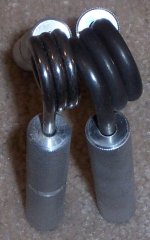
What is your potential?
The question is often raised regarding the limit of human potential for closing grippers. Individuals new to the implements will vary in their reactions, with some professing they will be able to close the COC#4 in months, and others thinking even the COC#2 is outside of their potential. Putting the gripper difficulties in perspective takes time.
- Captains of Crush #T – There are office workers that will be stopped by the COC#T. This is a result of inactivity in most cases and progression to harder grippers can occur quickly with training. Several men have progressed from the inability to close the COC#T to the ability to close the COC#3. Closing the COC#T is well within the range of most women with some training.
- Captains of Crush #1 – The COC#1 will be closed with no training by most strong men, as well as those with a background doing manual labor. Many women are capable of training up to this level with some effort. Some female strength athletes will close the COC#1 with no training.
- Captains of Crush #2 – Developing the ability to close the COC#2 is within the range of most males and some talented females. While the COC#2 will stop many experienced strength athletes on their first attempt, this is often a result of lacking proper technique on the grippers, not a lack of strength. Mastery over the COC#2 is achievable without a full body strength training program.
- Captains of Crush #3 – Most healthy males have the potential to build the ability to close the COC#3 gripper. Reaching this level will require an individual to be strong all over, training more than just their grip. While rare, there are some athletes that have closed the COC#3 the first time they used a hand gripper. Most talented strength athletes peak their gripper closing ability somewhere between the COC#3 and COC#4 grippers.
- Captains of Crush #4 – The most talented grip trainees in the world are able to close the COC#4 after quite a bit of extensive training. Very few individuals will reach this level even with dedicated effort. Those individuals who do reach this level are exceptionally talented strength athletes. While not the pinnacle of human potential, it is unlikely grippers much more difficult than the COC#4 will be closed without chemical or genetic assistance.
Gripper Seasoning
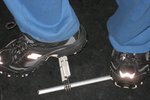
Improper seasoning will quickly damage a gripper.
Torsion springs experience a period of seasoning after initial creation. During this seasoning period, the resistance and spread of a spring will diminish slightly. Taking approximately 100 closes, the final resistance of a gripper will not be known until the seasoning period is complete. Once seasoned, gripper difficulty will remain constant over time.
In an effort to train on an implement of known resistance, some individuals will season a gripper prior to training with it. An appropriate method for seasoning is to slowly close the gripper handles with two hands until they barely touch, then allow the spring to open. Another option is to simply season the gripper by training with it over time.
The following approaches to seasoning a gripper may damage it, resulting in a lower resistance than the normal range for the specific model of gripper:
- Rapidly shutting the gripper handles may heat the spring, weakening it
- Closing the gripper handles violently may bend the spring, weakening it
- Closing the gripper handles with a rod through the eye of the spring may bend the spring, weakening it
These factors are not part of normal gripper seasoning and must be taken into account when referencing “seasoned” grippers. Most often seasoning problems of this nature will occur when an individual passes a rod through the gripper spring and stomps on it repeatedly in order to season it.
Gripper Spread
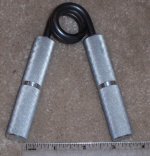
This gripper has a spread of 2 and 15/16 inches.
Gripper spread is the shortest distance between the bottoms of the two handles of the gripper. Normally gripper spread is 2.75” to 3”. Some grippers will have a wider spread, up to 3.5”. Narrow grippers are available by several manufacturers, with spreads around 2.25”
Gripper variance

Two #2 grippers. The right one is much harder.
Quite simply, grippers vary. Ten different grippers of the exact same spring diameter from a single manufacturer will have ten different strengths. This variance is significant, resulting in gripper models providing a range of difficulties, rather than a single consistent resistance.
It is not unusual for one gripper to be ten percent harder than another gripper of the exact same model. Differences in the tightness of the spring coil, spread of the gripper handles, and depth with which the spring is set all influence how hard a gripper will be. Further complicating matters, variations in the batch of spring steel and cooling process used also impact the gripper strength.
Gripper comparison
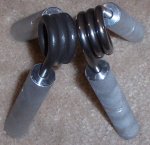
The gripper on the left is slightly easier.
The only accurate way to compare two grippers of similar strength is to close both of them. Due to variance in grippers, models from specific manufacturers can only be ranked in terms of general difficulty.
Guidelines can be established for progressing in difficulty from one gripper model to another. These are primarily based upon spring size and individual experience trying grippers from multiple manufacturers. Current gripper progression charts can be found on the Gripboard and will not be maintained on this site. Manufacturer published ratings cannot be relied upon, as each manufacturer measures their gripper strengths in different ways.
An engineering firm called PDA attempted to create an accurate numerical representation of the strength for an individual gripper. Even with extensive testing and access to the most experienced grip enthusiasts in the world, accurate numerical calibration for the difficulty of closing a gripper could not be established. Anyone interested in attempting to devise a method of comparing grippers is encouraged to review PDA’s calibration work first.
Gripper Brands

Beef Builder gripper vs. Captains of Crush gripper.
Heavy duty hand grippers are produced by a variety of manufacturers. While the basic training tool is the same, variations across manufacturers do occur. Characteristics of the most popular grippers are as follows:
Captains of Crush – Produced by Ironmind, these are the most popular heavy duty grippers and the standard by which all other grippers are judged. Knurling on the handles is middle of the road, with average gripper spread between 2.75” and 3”. Spring durability is high, with limited seasoning impact on gripper strength and spread.
Beef Builder – Hand made by Warren Tetting and distributed by Weightlifters Warehouse, these are the most popular grippers for bridging the gap between the Ironmind grippers. Knurling on the handles is more aggressive, with average gripper spread between 2.75” and 3”. Spring durability is high, with limited seasoning impact on gripper strength and spread. The following models are typically used to bridge the gap between Ironmind grippers:
- COC#1 to COC#2: Beef Builder Super Advanced; Beef Builder Master
- COC#2 to COC#3: Beef Builder Super Master; Beef Builder Grand Master
- COC#3 to COC#4: Beef Builder Elite; Beef Builder Super Elite
Warren Tetting originally produced the Ironmind grippers and has been hand making torsion spring grippers longer than anyone. He may be contacted personally to order custom grippers with any possible variation, including narrow spreads, extended handles for negatives, and steel handles to reproduce the feel of the original Ironmind grippers.
Heavy Grips – The gripper for those on a budget, Heavy Grips can be purchased new in sets for as little as $13 a gripper. The spread is narrower than an average Ironmind gripper, typically seasoning down to 2.25”. The knurling is quite a bit smoother than any of the other gripper manufacturers. Spring quality is lower, resulting in greater variance of gripper difficulty and spread as a result of the seasoning process.
Baraban – Produced by Robert Baraban in Austria, these hand made grippers provide the most extensive range of options for those looking to customize. Grippers can be ordered with steel handles, brass handles, colored handles, chromed springs, and engravings. Knurling is similar to the Ironmind grippers. Baraban gripper handles do have a slightly larger diameter than other gripper models. Spring variation after the seasoning process is greater than found in the Ironmind or Beef Builder gripper lines.
PDA SOS – Produced for a limited time by PDA, the SOS grippers were an attempt at producing a line of grippers with consistent, predictable ratings. High engineering tolerances were used in an effort to solve the problem of gripper variance. It didn’t work. PDA no longer sells these grippers, but they may be purchased used online. Quality of finish tends not to be as high as the Ironmind grippers, but they are a piece of grip history.
